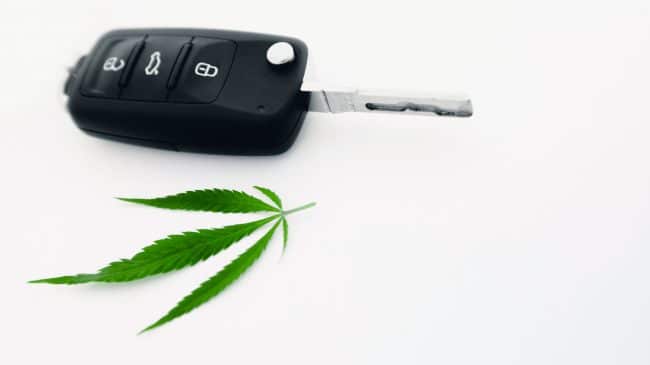On Oct. 7, Massachusetts Gov. Charlie Baker’s office issued a press release urging the passage of impaired driving legislation that is based on recommendations from the Special Commission of Operating Under the Influence and Impaired Driving.
“As Massachusetts continues to implement adult use of marijuana, including potential social consumption sites, it’s vital that we update our impaired driving laws to ensure the safety of everyone who uses the Commonwealth’s roads,” Gov. Baker said in the press release.
The proposed legislation, informed by input from several stakeholder groups and spurred by last month’s approval of regulations for social consumption of cannabis, seeks to implement the following (paraphrased) changes in the judicial approach to driving while impaired by THC (the intoxicating component of cannabis). The law would:
- Authorize courts to stipulate THC ingestion as impairing to driving.
- Extend implied consent authority to suspension of licenses for refusal of chemical testing, as with alcohol.
- Develop educational materials on drug impairment for trial court judges.
- Expand DRE (drug recognition expert) officer training and allow testimony as expert witnesses in civil and criminal cases.
- Statutorily prohibit open containers of marijuana, as is currently the case with alcohol.
- Empower police to seek electronic search warrants for (blood-draw) evidence of chemical intoxication after probable cause is established.
- Permit judicial stipulation of the scientific validity and reliability of HGN (horizontal gaze nystagmus) to demonstrate intoxication.
Some of these proposed changes make sense and largely track with Reason Foundation’s recommendations in the study, “A Common Sense Approach to Marijuana-Impaired Driving.” THC is a proven intoxicant, and since drivers’ insobriety can cause, and has caused, fatalities, public safety dictates that implied consent must extend to all intoxicants, including legal cannabis products containing THC.
Trial court judges should have the means to educate themselves about drug impairment. Drug recognition experts (DREs), who are police officers trained and certified in the detection of intoxication and impairment in individuals, should be considered expert witnesses and should be trained in numbers commensurate with need.
But a few of Massachusetts’ recommendations have little or no connection to driving impaired by THC, and therefore bear review. For example, prohibiting open containers of marijuana would parallel the open container prohibition of alcohol, but what exactly does that mean? Is a closed Ziploc bag containing legal cannabis considered an open container? If so, what would this mean for a medical marijuana card-holder transporting his medication? Unlike alcohol, marijuana has recognized medicinal uses, putting it more in the category of someone driving with intoxicating medications like, say, Valium. Thus, for medical marijuana card-holders, open-container laws should treat their prescription medication the same way other intoxicating medications are treated.
Even further afield is the commission’s recommendation on blood-draw evidence search warrants. While there is no legal problem allowing police to seek electronic search warrants for chemical evidence once probable cause (the grounds for arrest) has been established, blood evidence of THC ingestion is not conclusively linked to intoxication. THC processes differently in the body than alcohol and can be present in blood samples for weeks after ingestion (urine will show THC metabolites for even longer)—long after the subject is sober. While some states have set statutory per se blood plasma levels, seeking to parallel .08 blood alcohol content (BAC) for alcohol, THC blood levels don’t track with intoxication except at very high doses. A per se statute for blood evidence that sets the bar low enough to charge every THC-intoxicated driver could inadvertently punish sober drivers, while a bar set very high to charge only absolutely intoxicated drivers could fail to remove many intoxicated drivers from the roads.
THC is simply different metabolically from alcohol and for policymakers to pretend otherwise is unwise. While blood evidence can establish that a driver is a marijuana user, a need to establish intoxication rather than merely past use, especially for medical marijuana users, questions the relevance of such evidence.
Finally, Massachusetts’ last recommendation judicially stipulates the scientific validity and reliability to demonstrate intoxication of horizontal gaze nystagmus (HGN). This involuntary jerking of the eyes when the gaze is held at the outermost edge of vision is indeed scientifically valid and reliable—but not for THC.
HGN occurs primarily with depressants, PCP, tranquilizers and alcohol. The degree of HGN corresponds to the degree of intoxication, most precisely with alcohol. A trained officer dealing with a driver intoxicated by alcohol alone can estimate the driver’s blood-alcohol level very accurately through observation of HGN. But this has nothing to do with cannabis.
It’s possible that such a recommendation seeks to redress an omission in the law related to alcohol-impaired driving. Or if this recommendation seeks to address the well-proven synergistic effects of alcohol and THC consumption—together they are more intoxicating than the sum of their parts—then it should be written as such, possibly something like: Authorizing courts to stipulate that concurrent intoxication by alcohol and THC is more impairing than both alone.
So what should the judicial system use as grounds for arrest for driving under the influence of drugs? Just as police officers have been doing for decades with drivers intoxicated by prescription medication, designer and other drugs that labs can’t test for, and even for alcohol intoxication in drivers who are greatly impaired but below .08 BAC, the field sobriety test assesses divided attention skills—the very skills needed to drive a car safely. This approach directly targets impairment and is best done with the corroboration of body cam evidence when possible. A drug recognition expert’s evaluation seeks to identify the drug(s) involved for laboratory and prosecutorial purposes, but demonstrated impairment should be the focus and reason for getting the driver off the public roadways.

